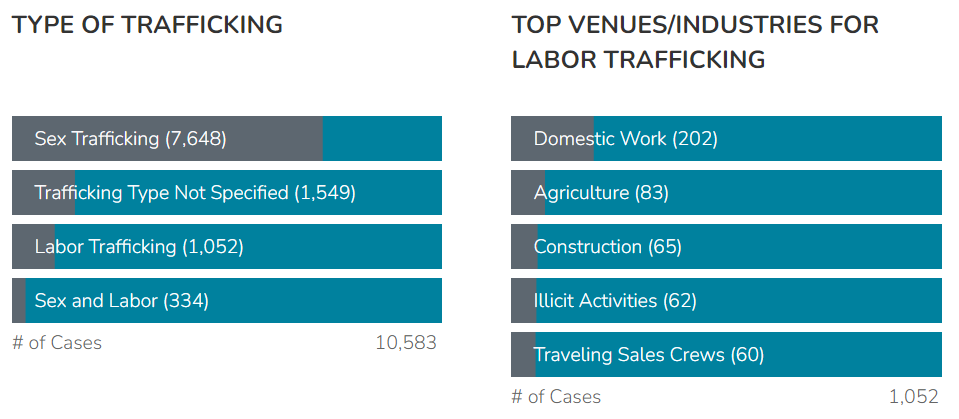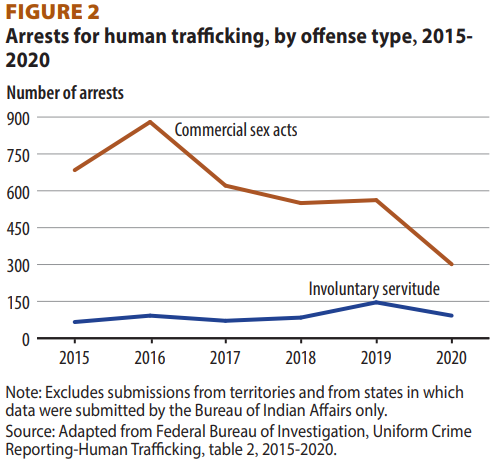
Human Trafficking: The State Of Forced Labor — An Introduction
By a Biometrica staffer
Ever since the Covid-19 pandemic struck, all manner of criminal activity also increasingly shifted to the virtual world. That included human traffickers, who began to use online channels more and more to conduct their activities. They used digital platforms to groom victims of all ages and genders for sex trafficking, recruit unsuspecting employment seekers into their illegal activities, and lure migrants, refugees and minors into involuntary servitude.
In this piece, we take a quick dive into one particular aspect of human trafficking: forced labor, or labor trafficking. We examine the definition of forced labor, the forms it normally assumes, the current state of forced labor, and the kind of labor trafficking trends seen over the last few years.
What Is Labor Trafficking?
Before we take a detailed look at labor trafficking, it’s important to define what it is, per experts and policymakers. In the United States, there are two main types of trafficking in persons that have been officially defined. Those are forced labor and sex trafficking.
The broader term, trafficking, is used to refer to a crime that involves the exploitation and profiting of a trafficker at the expense of adults or children by “compelling them to perform labor or engage in commercial sex,” according to a definition by the U.S. Department of State.
In cases where the victim is younger than 18 and is used to perform a commercial sex act, it is considered a crime regardless of whether there is any force, fraud or coercion involved.
According to the department, forced labor covers the “range of activities involved when a person uses force, fraud, or coercion to exploit the labor or services of another person.” It goes on to add that there are three main elements that constitute the crime of forced labor: the act, the means, and the purpose.
The ‘act’ is when a trafficker recruits, harbors, transports, provides, or obtains a person for labor or services. The ‘means’ includes a trafficker’s use of force, fraud, or coercion. And the ‘purpose’ focuses on the perpetrator’s goal to exploit a person’s labor or services.
Separately, the Bureau of Justice Statistics’ (BJS) in its Human Trafficking Data Collection Activities, 2021 report defines involuntary servitude as “obtaining of a person(s) through recruitment, harboring, transportation, or provision, and subjecting such persons by force, fraud, or coercion into involuntary servitude, peonage, debt bondage, or slavery (not to include commercial sex acts).
Types Of Forced Labor
Per the Department of State, there are two main types of forced labor that are frequently identified. Here’s a brief look at them:
- Domestic servitude: This is a form of forced labor where the victim is required to work in a private residence. When this happens, certain unique vulnerabilities arise. For one, it ensures that the domestic worker is, most often, in isolation. Their employers control all aspects of their lives from food to housing and transportation. What happens inside a private residence is also hidden from the outside world and, often, makes it tough for law enforcement to identify victims. Foreign domestic workers are most vulnerable to this form of forced labor or labor trafficking due to language barriers and the lack of community support.
- Forced child labor: This term is used to describe any scheme in which traffickers target children with the intention of compelling them to work. Why? As with foreign domestic workers, or migrants, or women, children are a vulnerable target group for all manner of criminals. It’s important to note here that children can work legally in certain kinds of work. But forcing or coercing children to work is illegal. Even so, slavery-like practices of selling children, forcing them to work, debt bondage and serfdom of children continue to exist.
Current State & Trends In Labor Trafficking

There were 10,583 human trafficking cases in total reported in 2020, according to the National Human Trafficking Hotline. In 2019, there were 11,494 cases reported, while that number was 10,906 in 2018, per the Hotline statistics.
The number of human trafficking cases filed has been on the rise since 2016 (it was 8,775 in 2017, and 7,742 in 2016) but dipped in 2020, when a major portion of the world was locked down due to the pandemic.
The number of calls that the Hotline receives each year, however, continued to increase even in 2020. That number went from 5,275 calls from victims & survivors in 2016 to 8,257 in 2018 and 13,594 in 2020. In 2019, 10,575 calls were made by victims & survivors to the Hotline.
The number of criminal forced labor cases filed in 2021 increased 22% when compared with 2020, according to the Human Trafficking Institute’s Federal Human Trafficking report. The report adds that victims of forced labor were mostly recruited through:
- fraudulent job offers
- visa promises
- promise of essential resources
- promise of shelter
- or, through pre-existing relationships with the recruiter
The institute’s report further adds that 93% of identified victims in new forced labor cases were foreign nationals. That trend resonates with what the Polaris Project says in a separate report about labor trafficking.
Between 2018 and 2020, 15,886 victims of labor trafficking were identified through the Hotline, according to a Polaris Project report. During that time, more than half the victims of labor trafficking reported to the Trafficking Hotline whose immigration status was identified were foreign nationals holding legal visas of some kind, including temporary work visas, the report adds.
Meanwhile, the BJS’ Human Trafficking Data Collection Activities, 2021 report shows that involuntary servitude was on the rise between 2017 and 2019. It dipped in the year 2020, per BJS data. Information for the year 2021 is not yet available on the BJS website.

It’s important to note here that the way labor trafficking is measured differs from one report to another. Nevertheless, by examining various datasets, we can arrive at a high level view of the current state of labor trafficking.
From these various reports, it appears that cases of labor trafficking or forced labor are still, largely, on the rise, particularly under certain circumstances (i.e. when it comes to foreign nationals or immigrants). Some fear that trafficking and abuse has become far too commonplace in the lives of many guest workers to the country.
As trafficking of all kinds becomes more widespread, it is equally important to battle it. Like the Secretary of State, Antony Blinken, says in the 2022 Trafficking in Persons report: “Everyone should be free. And yet, through force, fraud, and coercion, human traffickers violate this most basic right.”